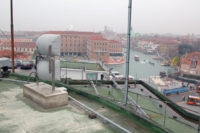Four years after a student gunned down 32 people in a rampage, Virginia Tech University officials remain adamant that they did nothing wrong by waiting two hours to warn the campus that a gunman was on the loose. Virginia Tech says it acted reasonably based on standards in place at the time and doesn’t deserve the $55,000 fine that the U.S. Department of Education imposed on the school for violating federal law with its response the day of the shootings. As of press time, they had yet to decide on whether or not to appeal the fine.
Still, no university wants to repeat Virginia Tech’s supposed mistakes. Campus safety experts say the sanctions and Tech’s response provide a test case for how universities should respond in the future, their “new role,” so to speak. “This is literally higher education in the world on trial,” said Peter Lake, a Stetson College of Law professor and director of the Center for Excellence in Higher Education Law and Policy, in an APreport. “They didn’t ask for this, but they’ve been nominated by fate to play this important role.”
Charting New Ground
In a sense, the events at Virginia Tech University in April 2007 revolutionized the way colleges approach student safety. It birthed mass alert systems and sweeping surveillance. Now schools are expected to instantly send e-mails and text warnings in the event of an emergency.
For example, a full-volume test of the Seahawk warning siren system took place earlier this year on the campus of the University of North Carolina – Wilmington (UNCW). The exercise even included an emergency cable TV interrupt test.
The purpose was to test the effectiveness of mass notification, a growingly important part of college and university crisis management procedures and message delivery systems across diverse types of communications means. At the university, use of these tools will vary based on the nature, duration and severity of an emergency. Some of the ways in which campus emergency notifications and up-to-date information may be communicated include the sirens, the UNCW Emergency Information Hotline, blast e-mails, the UNCW Alert Web site and mass text messages.
In an unprecedented move, UNCW installed two outdoor warning systems on its main campus in 2007. Last year, it installed an additional three sirens to enhance coverage. The strategically placed sirens warn the university community to take shelter in a major emergency, such as a severe weather event. The siren will be sounded only during major emergencies when the majority of the UNCW community will need to shelter in order to stay safe.
In another way to get the word out, students, faculty and staff provide their cell phone numbers for emergency text and voice messaging, which requires voluntary sign-up. This is one of multiple communication tools UNCW may use to provide critical information to the campus community during emergency situations.
Last month, as part of its emergency preparedness plans, Duke University tested its DukeALERT mass notification system. Outdoor warning sirens sounded and the emergency DukeALERT Web site was activated. Faculty, staff and students received a test e-mail, and, if they registered for Duke’s text messaging service, they received a text message on their mobile device.
The purpose was to get people to understand how they would be notified in the event of a life-threatening emergency like a tornado sighting or active shooter on campus.
Duke University officials say the test is conducted once during the spring and fall semesters and once during the summer, when the audience is significantly different with various camps and programs on campus.
As part of the test, Duke community members were encouraged to respond to an online survey to assess the effectiveness of various DukeALERT communication methods. The results, say Duke University officials, will help determine how people were notified, which methods worked best for different groups and whether staff members know their severe weather/emergency conditions service category. The results will also help identify areas for improvement.
Thinking Ahead
Information on how a mass notification system works, or doesn’t, is the next step for Kutztown University of Pennsylvania, which will soon request official feedback on its mass notification system from its students and staff.
The university’s Office of Environmental Health and Safety, led by Director Stephen S. Helms, was proactive in its thinking about the potential of a mass notification system on campus. In the early 1990s, the university retrofitted all residence halls with voice-communication fire alarm systems that included speakers – and prerecorded messages that instruct occupants what to do in the event of an emergency. Yet, the missing link, Helms says, was other campus buildings and outdoor spaces.
The university recently installed a fiber optic network and a voice command center that now allows university emergency management officials to send select messages to a group of buildings or select buildings. “We have tremendous flexibility to get audio out to certain groups of buildings or to one building,” Helms says. “The early planning in the 1990s postured us very well into the 2000s. With upgrades to our fiber optic network and voice-communications fire alarm system, we are now able to send a multitude of messages, live or prerecorded for severe weather, active shooter, or general campus evacuation situations. We have the capability to get the message out when we need to do so.”
Thinking ahead, Helms is considering reaching students, faculty and staff via digital message boards and equipping KU’s Gai-Tronics’ outdoor emergency telephone stanchions, placed along walkways and parking lots, with speakers to spread emergency messages even further. Where stanchions are not possible to install, Helms says he will broadcast messages via speakers mounted on campus buildings.
The system was tested in January of this year, when excessive snowfall and a heavy rainstorm flooded a parking lot. “We used the system to alert people to move their cars and stay out of the area,” Helms says. “It resulted in a very quick response.”
Beyond that, an additional test in March proved successful as well. An additional test of the system with formal feedback is planned to take place within the next few months.
|
Root Root for Security No one is sure if professional football teams will be playing in September, but if they are, the Cleveland Browns will be prepared. It’s yet another way that mass notification takes on a whole new role. Lewis Merletti is senior vice president of the Browns and a former director of the United States Secret Service. On his team is Carl Meyer, vice president of security and a former Secret Service Agent; Kat Mathis, an associate in the Senior VP’s office who formerly worked for the CIA; and Ken Rundle, manager of the Training Facility and Security and a former counter-sniper with the Secret Service. All are experienced in dealing with critical situations, and they realize the need for swift and reliable communications. Merletti uses a Send Word Now Alert Service to notify players and staff, whether it be a simple snow warning or a more serious terror event. On the field the Browns’ plays are called and executed with precision, and off the field the Browns’ organization-wide communication and travel plans are equally well-orchestrated. There are secure motorcades to the airport, hotel and other destinations when the team travels together. “When there is a last-minute change in schedule, we need to get the word out to players, coaches and support staff,” says Merletti. Coordinating maneuvers off the field can be almost as tough as on the field, with a team of 53 players and 150 total staff members who travel and work together. Merletti said it is important to be able to reach people via any available mode of communication or device they have with them. “If someone is going to be late for a bus, it’s not like they can just catch up and get on at the next corner. Everything has to be planned and coordinated – we can’t afford for anyone to miss a trip,” says Merletti. Mathis agreed that the security system is essential to the team’s security plan. “There are two separate Browns facilities in Cleveland that are 15 miles apart. The ability to communicate organization-wide regardless of physical location is a key concern for the Brown’s organization.” |





